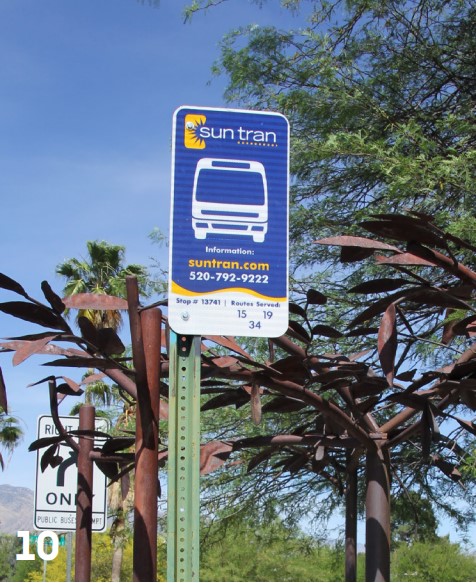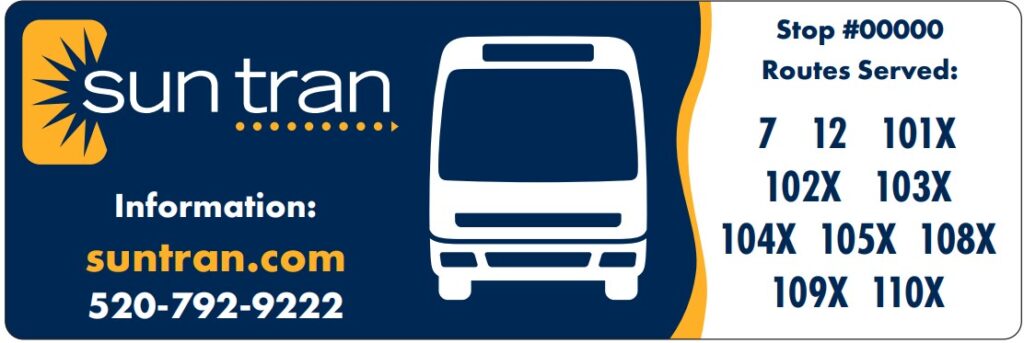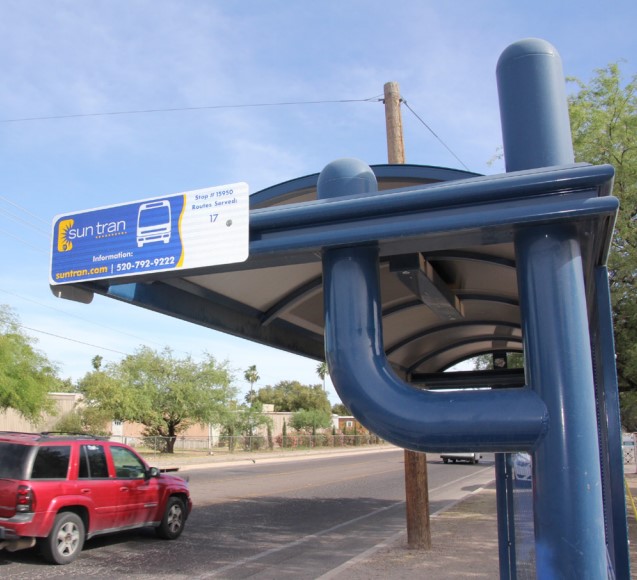Transit Centers & Bus Stops

Transit centers and bus stops keep our community connected, offering convenient, accessible places to board the bus. Our three transit centers serve as key hubs; meanwhile, more than 2,200 bus stops are placed throughout the City of Tucson, unincorporated Pima County, Oro Valley, Marana, South Tucson, and Pascua Yaqui.
Transit Centers
Tucson has three transit centers: Laos, Ronstadt, and Tohono. All transit centers are located in different parts of the city, from South Tucson to Downtown to Northwest Tucson. Each transit center offers seating, shade, and restrooms. Customer Service Representatives can be located at the Laos and Ronstadt transit centers from 8 a.m. to 4:30 p.m. Monday through Friday.
Laos Transit Center
The Roy Laos Transit Center is located on Tucson’s south side and was the first transit center in the city. It is named after Roy Laos, the founder of Occidental Bus Lines. On weekdays, the transit center sees more than 109,000 passengers boarding and deboarding. It serves routes 2, 12, 18, 23, 24, 25, 26, 27, 29, and Sun Shuttle routes 421X, 430, 440, and 486. Across from the transit center, there are also stops for Sun Express routes 203X and 204X. This center also offers a convenient park-and-ride facility, allowing passengers to park their vehicles and transfer to public transit.
Ronstadt Transit Center
Ronstadt Transit Center is located in the heart of Downtown Tucson and is named after the famous Ronstadt family. On weekdays, the transit center sees more than 662,000 passengers, making it the busiest transit center in the city. It serves routes 1, 2, 3, 4, 6, 7, 8, 10, 12, 16, 18, 19, 21, 22, 23, 25, and Sun Express routes 101X, 102X, 103X, 104X, 105X, 107X, 109X, and 110X. It also serves Sun Shuttle route 421X. Within walking distance, passengers can easily connect to the Sun Link streetcar!
Tohono Tadai Transit Center
Tohono Tadai Transit Center is located on the northwest side of the city and was the first center designed under the Americans with Disability Act (ADA) guidelines. On weekdays, the transit center sees more than 62,000 passengers. It serves routes 6, 15, 16, 17, 19, 34, 61, and Sun Shuttle route 412. This center features a convenient park-and-ride, allowing passengers to park their vehicles and easily transfer to public transit.
Bus Stops
Sun Tran bus stops are designed for comfort and accessibility, with features like benches, shelters, and clear signage to help passengers navigate their trip. Each bus stop includes a bus stop sign, which includes what routes it serves, the stop number, and Customer Service Information. To learn more about riding Sun Tran, click the button below!
What our bus stops and signs look like:




Bus Stop Maintenance
Please get in touch with Sun Tran Customer Service at (520) 792-9222 or suntraninfo@tucsonaz.gov, or submit a request HERE related to:
- Missing, damaged, or vandalized bus stop signs, shelters, or benches.
- Overflowing trash cans, litter, cigarette butts, bugs or graffiti at a bus stop.
- Homeless camos or people loitering at a bus stop.
- Requesting a new bus stop, bench, or shelter.
Bus Stop FAQS
How do I report a bus stop that needs attention?
Contact Sun Tran Customer Service at (520) 792-9222 or suntraninfo@tucsonaz.gov, or submit a request HERE. Translation assistance is available; call Customer Service, press 03 (three), and say the language you need.
Who maintains Sun Tran bus stops?
Sun Tran’s bus stop maintenance team is responsible for minor repairs and cleaning. Larger repairs are funded by the jurisdiction.
Who addresses unwanted behaviors at bus stops?
For non-emergencies, call the City of Tucson’s 311 non-emergency line to report excessive loitering at bus stops. For emergencies, call 911.
How do I request a new bus stop or change an existing bus stop?
Contact Customer Service at (520) 792-9222 or suntraninfo@tucsonaz.gov, or submit a request HERE. Please know that all requests will be carefully evaluated; however, fulfillment cannot be guaranteed.
How are bus stop improvements prioritized?
Ridership is the main factor considered. Other factors may include Public Right-of-Way limitations, feasibility, equity & equality, surrounding land use, bus stop history, accessibility, and re-existing infrastructure. Click the button below to learn more about how Sun Tran prioritizes bus stops!